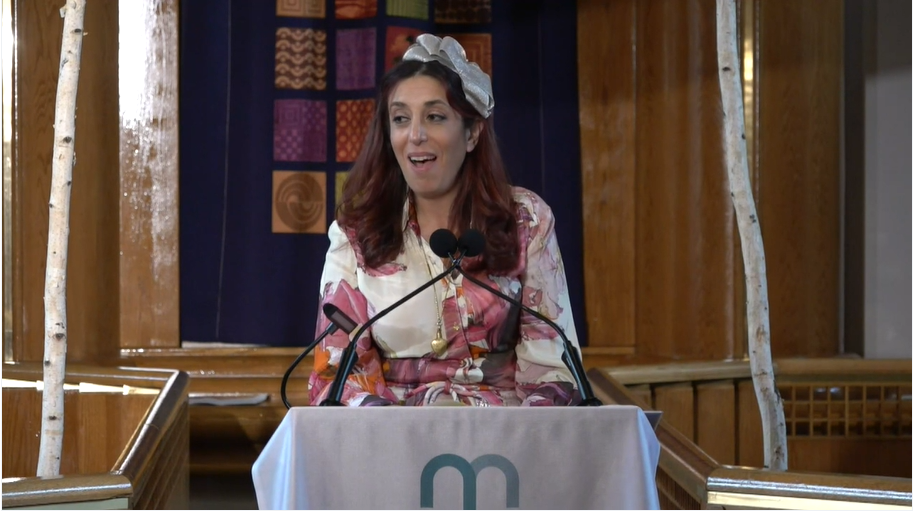
Banner

Roth attributes rabbinical ordination to SA roots
When educator Adina Roth was finally ordained as an Orthodox Jewish rabbi in New York on 3 June, she couldn’t quite find the words to describe how moving and beautiful it was.
“Our rabbis charged us to become the kind of rabbis the world needs right now,” says Roth from New York this week.
Roth is only the second South African-born Jewish woman to achieve Orthodox smicha.
It has been a long road for Roth, born and raised in South Africa, where she lived until recently, and she says South African Jewry played a crucial role in getting her where she is today.
“When I told people in South Africa I was on this path, everyone I spoke to was excited for me, supported my decision, and were excited for what this meant for our community,” Roth says. “The calling to be a rabbi found me through my life’s work and my love of Torah and Jewish learning. It wasn’t a desire for a title, but to be able to work for the community and serve as an educator and in a spiritual and religious capacity.”
Being ordained “was probably one of the most powerful moments of my life,” she says. “My wish is that all Jewish girls in South Africa see something like this. As of last night [3 June], there are 75 musmachot [Orthodox-ordained women]. Our world is changing!”
Having emigrated from Johannesburg to Sydney during her studies, “I found that the study of Torah was a comfort,” says Roth. “I left behind so much that I love. But Jewish learning goes with you. Maybe this is how Jews managed to move around the world for thousands of years. Our Judaism has been a constant.”
Roth studied at Yeshivat Maharat, a Jewish educational institution in New York. It was the first Orthodox yeshiva in North America to ordain women. The word “maharat” is a Hebrew acronym denoting a female “leader of Jewish law, spirituality, and Torah”.
Roth did a four-year programme focusing on Talmud and halacha, studying mostly remotely alongside women from around the world. Two decades ago, as a student, she did two Masters degrees on Jewish texts and studied at renowned Jewish institutions abroad.
When she returned to South Africa, “I was approached by a group of families who wanted a meaningful rite of passage for their daughters for Batmitzvah, including the option to read from the Torah in a halachic setting,” says Roth. “For almost 20 years, I ran Barmitzvahs and Batmitzvahs, teaching boys and girls to lein from the Torah. I enjoyed running the ceremony which is, I suppose, a rabbinic role. I find it moving to walk people through the significant rites of passage of their lives using the beauty, depth, and potency of Jewish ritual.”
Roth also taught adults at the Melton Institute, and developed her own courses in Tanach and Midrash. “Learning Torah has the potential to have an impact on our being, to heal and refine our character and soul. All this led me to long for an opportunity to deepen my text and Jewish leadership skills,” she says.
“I was aware that since 2009, Yeshivat Maharat had begun to ordain women in orthodoxy, something I didn’t imagine could happen in my lifetime.” Eventually, she decided to take on the challenge. Each year, they focused on a different area of Jewish law.
“I loved how we learned halacha in a way that responds deeply to the needs of the individual,” says Roth. “The Jewish community of the 21st century has changed. People are single for much longer. People get divorced. People are in LGBTQ+ [lesbian, gay, bisexual, transgender, queer or questioning] relationships. We learned how to welcome and make space for all human beings.”
She emphasises that she couldn’t have done it without the support of her family. In addition, “Emanuel, the school where I work as director of Jewish Life, allowed me to study for one day a week and gave me huge support. It wasn’t easy to emigrate, look after a family, start a new job, and keep up my studies, but I was determined to graduate with my classmates.”
She doesn’t anticipate that her role [at Emanuel] will change too much after becoming a rabbi. “I hope that opportunities will open for me, such as facilitating rite-of-passage ceremonies and teaching adults. As an Orthodox rabbi, I wouldn’t lead prayers in the traditional sense. But even in orthodoxy there are some services, called “partnership minyanim”, where women can lead parts of the service within Jewish law.
“While it’s completely halachically permissible for a woman to be a rabbi, I believe in the idea of aseh lecha rav u’kneh l’cha chaver [make for yourself a rabbi, and acquire for yourself a friend],” says Roth. “Each person must find a rabbi for themselves. If people aren’t comfortable with a woman rabbi, they don’t need to seek rabbinic relationship with women. The ship has sailed, and women rabbis are good for Am Yisrael.”
Roth would encourage people to seek this kind of ordination. “Yeshivat Maharat is a professional institution geared to supporting women pursuing this path. If this is something that resonates, I would encourage you to explore options. I also encourage men to develop Jewish spiritual ‘muscle’. We need strong spiritual leadership at this hard time in our world.”
South African community members say Roth’s smicha is an important and well-deserved milestone. “The increasing drive by women to connect with halacha has led inevitably to them not only being educators but also halachic leaders,” says Ilana Stein. “The smicha programme at Maharat is incredibly intense and difficult. Professor Tamar Ross calls it ‘expanding the palace of Torah’, and Adina’s knowledge is doing just that.”
Nina Cohen remembers how “as Greenside Shul embarked on a path towards a more inclusive community, we turned to Adina for assistance. Adina became an invaluable resource, particularly regarding the inclusion of women in ritual.
“About seven years ago, she helped facilitate our first leining of Megillat Esther by women,” says Cohen. “This was the first time that this took place in an Orthodox synagogue in South Africa. On Simchat Torah, Adina organised a women’s hakafot [dancing with the Torah] service. Adina taught in the most humble yet insightful way.
“When Adina emigrated, I was afraid we wouldn’t be able to continue with the transformation she helped establish at Greenside,” Cohen says. “However, always inspired by her contribution, we’ve managed to continue. We’re so proud of Adina for having attained smicha. Never was an achievement more well-deserved! We’re so grateful for her contribution and unswerving dedication to Judaism in South Africa.”
Roth always thought she would come back to South Africa with her smicha, “and a part of me is sad that I won’t serve my own beloved community, who really made me the person I am today. I’m grateful for the schooling I got, for the youth movements of South Africa, to many teachers, and to the love of Yiddishkeit. Treasure the deep roots we’re given in our community, and if you want to explore options beyond it, reach for them too. It’s a big Jewish world out there, and we’re blessed to have access to it.”






